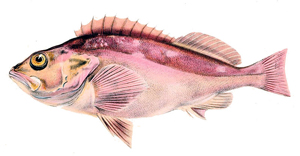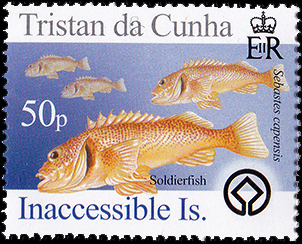Sebastes capensis J. F. Gmelin, 1789

Phylum: Chordata Haeckel, 1874
Subphylum: Vertebrata Lamarck J-B., 1801
Classe: Actinopterygii Klein, 1885
Ordine: Scorpaeniformes Greenwood et al., 1966
Famiglia: Scorpaenidae Risso A., 1826
Genere: Sebastes Cuvier, 1829
English: False jacopever, Cape redfish
Descrizione
È un pesce demersale che raggiunge una lunghezza massima di circa 37 cm (15 pollici) sebbene una dimensione più normale sia di circa 30 cm (12 pollici). La pinna dorsale ha circa tredici spine e tredici raggi molli e la pinna anale ha tre spine e sei raggi molli. Il colore generale di questo pesce è rossastro o marrone e ci sono cinque o sei macchie chiare sul dorso. Si nutre di piccoli invertebrati bentonici . È una specie vivipara, che trattiene le uova internamente fino alla schiusa. Nei fiordi del Cile meridionale, le giovani larve occupano i canali dove abbondano le uova di copepodi mentre le larve più grandi si spostano su aree di piattaforma dove la salinità è maggiore e le prede di copepodi più grandi sono più abbondanti. [7] Si nutre principalmente di mysids. È una specie economicamente importante per i pescatori artigianali, oltre ad essere parte delle catture accessorie nell'allevamento di aragoste a Tristan da Cunha e nelle indagini di pesca al largo del Sud Africa.
Diffusione
Si trova nelle acque subtropicali dell'Oceano Atlantico sudorientale sulle coste del Sud Africa, Tristan da Cunha e Gough Island. Un'altra popolazione potrebbe essere presente nell'Oceano Pacifico sudorientale al largo delle coste del Cile. L'intervallo di profondità per questa specie va da 20 a 275 m.
Sinonimi
= Scorpaena capensis Gmelin, 1789 = Sebastichthys capensis Gmelin, 1789 = Sebastes darwini Cramer, 1896 = Sebastodes chilensis Steindachner, 1898 = Sebastichthys chamaco Evermann & Radcliffe, 1917 = Sebastes chamaco Evermann & Radcliffe, 1917 = Sebastodes chamaco Evermann & Radcliffe, 1917.
Bibliografia
–Motomura, H.; Matsuura, K. & Khan, M. (2018). "Sebastes capensis". IUCN Red List of Threatened Species. 2018.
–Froese, Rainer; Pauly, Daniel (eds.) (2021). "Sebastes capensis" in FishBase.
–Eschmeyer, William N.; Fricke, Ron & van der Laan, Richard (eds.). "Species in the genus Sebastes". Catalog of Fishes. California Academy of Sciences.
–Milton S. Love; Merit McCrea; and Li Kui. "Aspects of the Life Histories of Pinkrose Rockfish (Sebastes simulator) and Swordspine Rockfish (Sebastes ensifer) with Notes on the Subgenus Sebastomus". Bulletin Southern California Academy of Sciences. 117. (1): 64-76.
–Christopher Scharpf & Kenneth J. Lazara, eds. (22 May 2021). "Order Perciformes (Part 8): Suborder Scorpaenoidei: Families Sebastidae, Setarchidae and Neosebastidae". The ETYFish Project Fish Name Etymology Database. Christopher Scharpf and Kenneth J. Lazara.
–Holthuis, L.B. "Who was Jacob Evertsen? Search for the identity of the godfather of some spotted groupers (Pisces: Serranidae: Epinephelinae)". Zoologische Mededelingen Leiden. 69 (6): 73-78.
–Landaeta, M. F.; Castro, Leonardo R. (2006). "Larval distribution and growth of the rockfish, Sebastes capensis (Sebastidae, Pisces), in the fjords of southern Chile". ICES Journal of Marine Science. 63: 714-724.
–Barrientos, Gonzalez and Moreno (2006). Geographical differences in the feeding patterns of red rockfish (Sebastes capensis) along South American coasts. Fishery Bulletin 104(4): 489-497.

|
Stato: Tristan da Cunha |
|---|